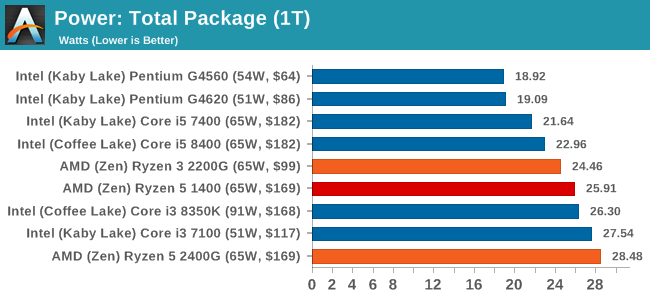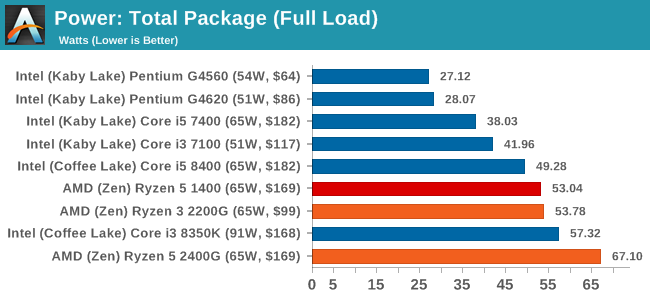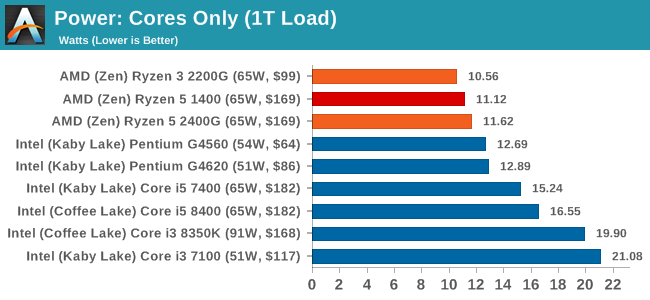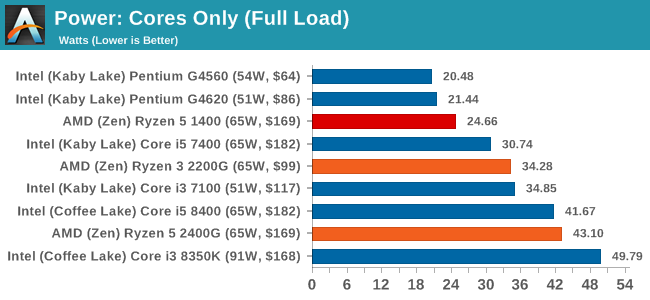Marrying Vega and Zen: The AMD Ryzen 5 2400G Review
by Ian Cutress on February 12, 2018 9:00 AM ESTPower Consumption
For our power consumption metrics, we use a Prime 95 blend on fixed threads to generate a strong load, and then poll the internal power registers that determine power state calculations to get the power consumption. Each processor is different in how it reports its power, which depends on the level of control the processor has: some of the more advanced CPUs, such as Ryzen, will provide per-core power numbers, while the latest Intel CPUs only give a figure for the CPUs as a whole but also include DRAM controller and uncore power consumption.
An interesting element to the power consumption on the Ryzen APUs, due to the unified power delivery subsystem in play feeding the CPU and the integrated graphics, is that the power registers only report half the power consumption when probed (e.g. when 14W, shows 7W). As of yet, we are unsure if this has a knock-on effect on how the processor adjusts its turbo modes in response to power consumption. Nonetheless, a simple scaling factor gives the following results.
Total Package: The Whole Processor
For this data, we take the values of the processor as a whole, which includes all the interconnect, memory controllers, PCIe root complexes, etc. The system is still only loading the CPU cores with minimal effect on the rest of the system, however depending on how the power is managed, some of the sub-systems still remain enabled.


At full load, the difference between the Ryzen 5 and the other Ryzen CPUs shows that the 2400G is using more of its upper margin, compared to the 1400 which is rated at the same power (note TDP is only determined at the base frequency), but the extra frequency of the 2400G means that there is extra power draw overall. Part of this is due to the Infinity Fabric, which we will see below. But what these tests also underline is that in a quad-core configuration, the Intel CPUs are still very power efficient.
Cores Only: Pure Work
For the processors that split out the data, we can look at the power consumption of the cores on their own, without any of the sub-systems, like uncore, mesh, or infinity fabric. This usually paints a different picture to the package power.


For the core only power, the Ryzen 5 2400G uses less power than the Core i3-8350K, despite the situation being reversed when considering the whole package. This means that Infinity Fabric takes a lot of power here, and the ring bus solution that Intel uses benefits from being simpler, and Intel can push more power to its individual cores.










177 Comments
View All Comments
Gonemad - Wednesday, February 14, 2018 - link
These chips will cause a major segment of low-end graphics cards to be buried, or have their prices cut down. I can't wait for the benchmarks, and see how many generations will be affected.callmesissi - Wednesday, February 14, 2018 - link
what an amazing apu... this makes all celerons / pentiums and half of i3 completely out of market! this apu is so good, so cheap, kills all the entry level gpus and basically all those intel cpus mentioned .way to go amd! now about those drivers and bios....
edlee - Thursday, February 15, 2018 - link
this is amazing by AMD, they need to keep the hits coming, and chipping away market share from intel. Intel has not made any progress on processor graphics in years, this is a super aggressive strategy by AMD that i think will work. Nvidia basically has to cancel out any gpu line below gtx 1030 by next year. Hopefully AMD comes out with a GTX 1050 killer by next year.CSMR - Wednesday, February 14, 2018 - link
I think the relevant Intel comparisons would be processors with Iris Pro or Iris Plus.Hixbot - Wednesday, February 14, 2018 - link
Do these APUs not compete directly with the new Intel-Vega chips? Why did AMD give Intel Vega, when AMD could have had the APU market all to themselves?SaturnusDK - Wednesday, February 14, 2018 - link
Not really. The i8809G as it's called is supposedly a mobile part if you can call a 100W TDP part mobile by any stretch of the imagination. It's based on a 22 (or 24) CU Vega and will be much much more expensive. Expect it to land somewhere in the $400+ range, ie. more expensive than an 8700Kfranco1961 - Thursday, February 15, 2018 - link
Hi Ian. Two questions: I have to do a cheap PC for video editing (Adobe Premiere, After Effcets, etc.) and I thought about a Ryzen 3 1200 and a Geforce GT 1030. You think this Ryzen 5 2400G goes for video editing by having a Vega 11? Another question: using DDR4 2400 would I have a strong performance drop or could it be okay? Thank you!rexian96 - Thursday, February 15, 2018 - link
A question for Ian or anyone who knows - Does 2400G not support HW encoding of H264/265 and just limited decoding? Or that Handbrake doesn't support it yet? Looking at the encoding score it would seem 8400 is miles ahead though the GPU in Ryzen is much stronger.csell - Friday, February 16, 2018 - link
Hi. Do you know the max videoram?Will it be possible to use Crossfire between the shared ram and a graphics card?
If crossfire will be limited to VEGA graphics card, will I hope AMD will introduce a cheap graphics card with just 8 or 11 Vega compute units and may be HDMI 2.0
SaturnusDK - Friday, February 16, 2018 - link
There will be no crossfire with dGPUs. It's no possible at all.